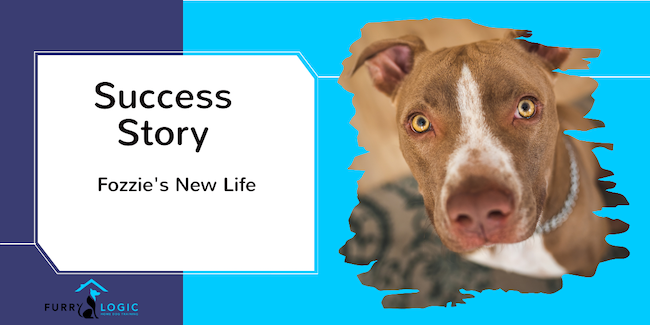– Furry Logic Home Dog TrainingThe owners’ dedication was crucial, and the process involved understanding and addressing unconscious cues that dogs interpret as dominance.

A Dog Training Success Story – Saving Fozzie’s Life
Our dog training success story today revolves around the rehabilitation of a Pit Bull named Fozzie, who was aggressive and fearful. The owners, concerned about their safety and their soon-to-arrive baby, sought our help with training.
Our coaching focused on building Fozzie’s confidence and respect through exercises like “follow the leader” and “door control.” Initial control was established in the home in about two weeks, and further training outside was successful.
The owners’ dedication was crucial, and the process involved understanding and addressing unconscious cues that dogs interpret as dominance. The training aimed to ensure Fozzie’s safety and improve his behavior, ultimately allowing him to bond with the family and be a good companion.
Fozzie’s Story – Breed Ban Makes a Family Move
The family who adopted Fozzie visited their local shelter and immediately fell in love. They were rescuing Fozzie from a destiny of euthansia and were so dedicated to saving his life and creating a place for him in their family that they even moved to another province!
They made the decision to relocate to Calgary because their home province had enacted breed-specific legislation which banned the ownership of Pit Bull dogs. Life was made even more complicated when they found out, within days of adopting Fozzie, that they were pregnant and expecting their first baby.
Fozzie’s Owners Contacted Furry Logic Home Dog Training in Calgary
They sent us an email saying they were moving into Calgary and they needed some help, because whenever this pitbull saw a dog or a car, he became uncontrollable, and if the owner tried to manage his dog, then the dog began jumping up to bite him. They didn’t want to be another news story about a pitbull attack! They knew if they surrendered the dog, it would be bad news and they really wanted to find a way to make it work.
We visited the family and conducted our evaluation. We knew immediately that this dog needed leadership and that if we were able to help give this dog confidence that his aggression levels would balance out. Fozzie needed to be able to focus on something other than protecting his people so he could relax and be a well-mannered dog.
Fozzie previously suffered a life of being fearful and scared and it caused him to behave in an aggressive way. Fozzie lacked the confidence required to be able to relax and let his guard down. And Fozzie turned into one of our greatest success stories.
When we first met Fozzie and his owners, we expected it would take 10-15 lessons to help turn him around. But the owners were so dedicated to doing everything it took to learn to communicate with their dog that they were able to achieve leadership of their dog within 3 lessons! This isn’t a typical situation and that’s why it’s such a success story!
The owners followed the prescribed homework exercises faithfully and to a tee, exceeding all expectations and within a very short time, they earned the trust and respect of Fozzie and in return, had a loving family dog they could live with. They knew their impending baby arrival would be a wonderful event where they didn’t have to fear for the safety of their baby.
Months later when the baby arrived, we were invited back to see how good Fozzie was with the new family addition. They were happy to credit everything to the training. You can check out their testimonial here. (It’s the fourth one under the Aggression section.)
The owners’ dedication was crucial, and the process involved understanding and addressing unconscious cues that dogs interpret as dominance. The training aimed to ensure Fozzie’s safety and improve his behavior, ultimately allowing him to bond with the family and be a good companion.
Initial Training Steps for Fozzie
The initial training focused on gaining control in the house, which took about two weeks. The owners were committed and took the training very seriously, which helped in the dog’s progress.
Fozzie’s training program followed these main steps over a 6 week period where the owners practiced what they learned as homework sessions between our formal visit lessons:
- Control in the home – Fozzie was taught he’s not “the guy to answer the door.” Owners learned to read Fozzie’s body language and how to communicate with him in his canine language so he could understand he didn’t have to be in charge and on guard every moment.
- Leadership exercises – Fozzie was guided by his owners through exercises and taught to practice door control, wait command, and follow the leader. We helped to open Fozzie’s mind and use his intelligence to get him to be more docile and trainable. We worked on unconscious leadership cues that Fozzie was receiving.
- Outdoor control – once everyone understood their leadership role in the home, they were ready to graduate to outdoor control where they learned about leash walking and we were able to work on the biting and reaction to cars and other dogs. Outdoors introduced a new host of distractions and Fozzie showed his owners attention, trust and respect. This was due to the owners’ dedication to practice and teaching Fozzie that he was safe.
The training process takes time; it’s not instant. But with dedication, there is hope. It usually boils down to communication between you and your dog and Furry Logic Home Dog Training helps to bridge that gap in communication between humans and canines.
Examples of Unconscious Cues That Make Dogs Feel in Charge
When a dog stands on the sofa or a table, it is working to garner your attention and assert its dominance. Dogs often try to get physical height in order to feel more powerful. This is one of the main reasons a dog will jump on its owners or strangers or on furniture in the home.
Dog training means you are teaching your dog (and yourself) a whole new lifestyle. You give your dog subconscious cues which allow him to establish his dominance in the house, even while you are sleeping! Sometimes letting your dog sleep in your bed can make him feel more powerful and in charge. Removing that privilege, even temporarily, can assist with training.
The bed is “THE TOP SPOT” (or so your dog thinks!)
This isn’t a problem for all dogs. But when there are behavioural issues, it’s one of the places we can look to as a potential solution. By not letting the dog sleep in your bed, or having the “top spot” in the home, it is a possible solution to helping you reestablish the leadership position needed to guide and train your dog.
Door Control, Leash Control & Leadership Techniques
Door control is a set of exercises where the dog should focus on the owner before going outside, which helps establish leadership. Leash control should be taught starting inside the house where there are fewer distractions and natural boundaries like walls which make it easier for us to train the dog.
Follow the Leader is an exercise which entails having the dog walk up and down the stairs with you and around the home on a leash. The dog’s head should never be further ahead of you than your leg. Once he’s past that point, he can no longer see you.
The point of the exercise is to teach the dog to watch YOU. If your dog tends to wander ahead, we can use a quick trick to get him to pay closer attention and change his desire so he wants to walk BEHIND you so he can “keep his eye on you!”
The quick trick is to suddenly change directions and do an about face when walking. Once you do this a couple of times, your dog will want to walk behind you so that he can figure out your next move. This technique helps us to work with the dog’s natural desire to pay attention to you, as the leader. It helps the dog understand who is in charge.
Graduating to Outdoor Control and Public Space Training
Liz describes how outdoor control was trained in Fozzie’s case, focusing on leash control and lunging. The training was done in a public area, which was helpful in teaching Fozzie to ignore distractions and focus on the owner.
Historically, outdoors for Fozzie was in a busy greenspace area out front of the home. There was always lots of activity because there was a bus stop nearby with people coming and going.
Fozzie seemed bothered by the fact he could see the heads of people over a 5-foot fence, walking to the bus stop. It seemed very upsetting and triggered his barking and lunging because he felt like they were too close where he needed to guard his territory and protect his people.
When the owners began working outdoors, using Follow the Leader exercises, he forgot about what was out there, and he was really intent on what his owners were doing. And as people were walking by, he started to realize he was safe. He had a relaxed mouth, his body language was open, he was, it looked like, just having fun.
It was such a huge difference, going from terrified being out inpublic and seeing all the scary people, dogs, everyone that was potentially threatening to him (in his mind.) All these things which previously scared him so much that his owners could not take him outside at all.
He was now a dog who was relaxed and appreciative of the fact that he could play and just focus on his owners. His body language was completely changed and he was able to just focus on them and have a good time with his owners.
Building a Dog’s Confidence and Reducing Aggression
Although it seems counterintuitive, when you increase your dog’s confidence, it will help to reduce aggression. If your dog is fearful and untrusting, his natural instinct will be to “be on guard” or on alert at all times. He will feel defensive and will resort to aggressive behaviours.
Once a dog feels safe and knows he can trust his owner to take the leadership position, he will understand he can relax. Proper training results in a dog with relaxed body language, an open mouth, a low wagging tail; all signs of a confident and relaxed dog.
Often training will result in a dog’s newfound focus on his owner and he will be looking forward to fun with his favorite person rather than focused on all his perceived dangers out in the world. This change of focus results in a calmer, happier dog who is a great companion.
Good communication between humans and dogs is key to success.
If you have questions or want to learn more about communicating effectively with your dog or just want to know more about dog training, please reach out! We’ve been helping families bridge the human-canine communication gap for more than 20 years. You can book your own private dog training lesson for your pack right here.







No comment yet, add your voice below!